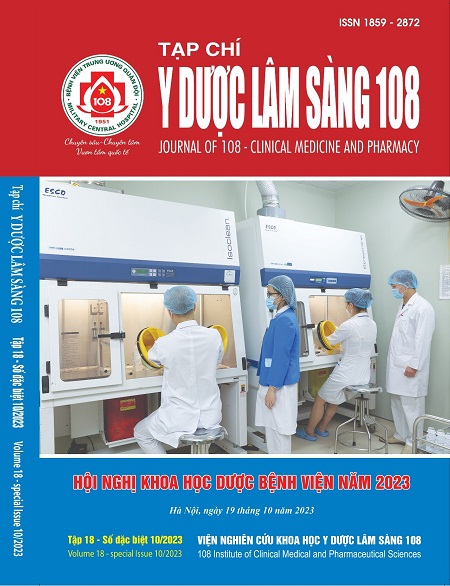The characteristics of antibiotic use in patients undergoing cesarean section at the Obstetrics Department, Tan Son District Medical Center
Main Article Content
Keywords
Abstract
Objective: To describe the characteristics of antibiotic use in patients undergoing cesarean section at the Obstetrics Department - Tan Son District Health Center. Subject and method: A retrospective study was conducted on 164 medical records of patients with indications for cesarean section with discharge dates from January 1, 2021, to June 30, 2021 and interviews with seven surgeons in the Obstetrics Department. Result: 85.4% of patients were 18-35 years old; 34.1% had indications for surgery due to previous cesarean section scars. 4.3% of patients had a high risk of surgical site infections, and the early prelabor rupture of membranes (PROM) was the most common (17.7%). The most prescribed antibiotic was ampicillin + sulbactam (90.24%). 100% of patients received antibiotics intravenously at the standard dosage. 63.4% of patients used antibiotics within 1 to 2 hours after surgery, and 100% continued antibiotic use for 5-7 days after surgery. 1.2% of patients had surgical site infections. No patient met all the criteria for antibiotic use according to ASHP recommendations. Conclusion: The main barriers to implementing antibiotic prophylaxis were the physicians' concerns about the lack of standardized procedures and the inefficacy of prophylactic antibiotics in bacterial eradication. In conclusion, most criteria for antibiotic use were not met, and the lack of trust in the efficacy of prophylactic antibiotics was the biggest barrier to implementing antibiotic prophylaxis.
Article Details
References
2. Baaqeel H, Baaqeel R (2013) Timing of administration of prophylactic antibiotics for caesarean section: A systematic review and meta-analysis. BJOG 120(6): 661-669.
3. de Jonge SW, Gans SL et al (2017) Timing of preoperative antibiotic prophylaxis in 54,552 patients and the risk of surgical site infection: systematic review and meta-analysis. Medicine 96(29): 6903-6903.
4. Culver DH, Horan TC, Gaynes RP et al (1991) Surgical wound infection rates by wound class, operative procedure, and patient risk index. National Nosocomial Infections Surveillance System. Am J Med 91(3B): 152S-157S.
5. ASHP Therapeutic Guideline (2013) ASHP Therapeutic guidelines on antimicrobial prophylaxis in surgery. Truy cập ngày 16/06/2023. Available from: https://www.ashp.org/surgical-guidelines.
6. World Health Organization (2016) Global Guidelines for the Prevention of Surgical Site Infection. Truy cập ngày 16/06/2023. Available from: https://apps.who.int/iris/bitstream/ handle/ 10665/250680/9789241549882eng.pdf?sequence=8&isAllowed=y.
7. Nguyễn Thị Kim Thu, Nguyễn Thị Hương Ly (2021) Đánh giá tình trạng nhiễm khuẩn vết mổ lấy thai tại Khoa Sản, Bệnh viện Trung ương Quân đội 108. Tạp chí Y Dược lâm sàng 108, tập 16 số 4, tr. 127-132.
8. Nguyen Thi Thu Thuy, Nguyem Thanh Hai, Nguyem Xuan Bach, Hoang Thi Thu Huong, Nguyem Chi Cuong, Pham Thi Thuy Van (2020) A Implementation of antibiotic prophylaxis program for cesarean section at Thai Nguyen National Hospital. VNU Journal Of Science: Medical And Pharmaceutical Sciences 36(4): 68-74
9. Lizán-García M, García-Caballero J, Asensio-Vegas A (1997) Risk Factors for surgical-wound infection in general surgery a prospective study. Infection Control & Hospital Epidemiology 18(5): 310-315.
10. Trần Việt Tân, Ngô Đức Toàn, Nguyễn Thị Bạch Tuyết, Nguyễn Đỗ Nguyên (2019) Các yếu tố liên quan đến nhiễm khuẩn sau mổ lấy thai tại Bệnh viện Từ Dũ. Tạp chí Y học Thành phố Hồ Chí Minh, phụ bản số 23 tập 2, tr. 170-176.
11. Bệnh viện Nhân dân Gia Định (2014) Phác đồ điều trị TP. Hồ Chí Minh. Bệnh viện Nhân dân Gia Định.
12. Gorecki P, Schein M, Rucinski JC et al (1999) Antibiotic administration in patients undergoing common surgical procedures in a community teaching hospital: The chaos continues. World J. Surg 23(5): 429-432.
13. Balk RA (2014) Systemic inflammatory response syndrome (SIRS): Where did it come from and is it still relevant today?. Virulence 5(1): 20-26.
 ISSN: 1859 - 2872
ISSN: 1859 - 2872
